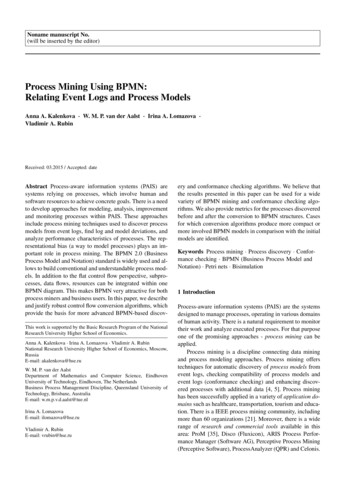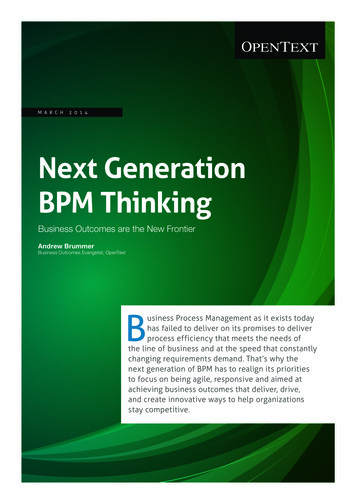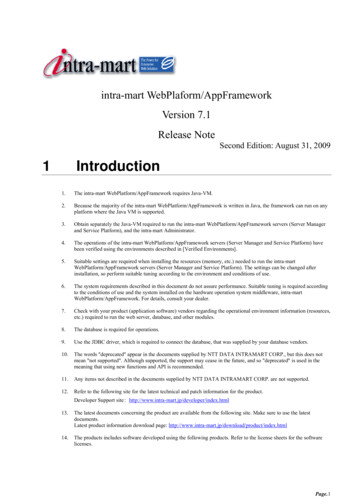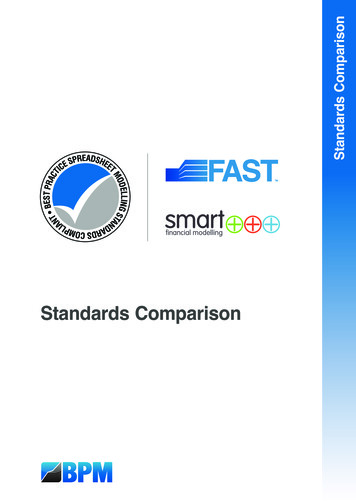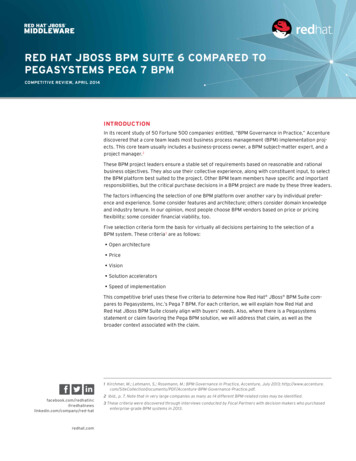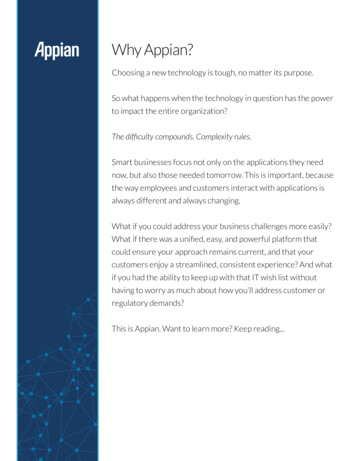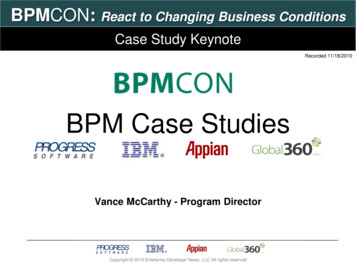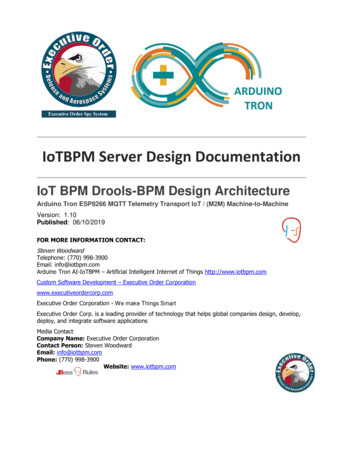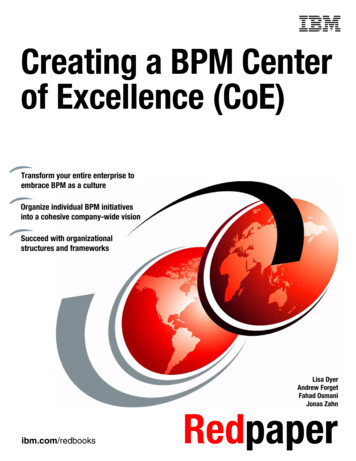
Transcription
Front coverCreating a BPM Centerof Excellence (CoE)Transform your entire enterprise toembrace BPM as a cultureOrganize individual BPM initiativesinto a cohesive company-wide visionSucceed with organizationalstructures and frameworksLisa DyerAndrew ForgetFahad OsmaniJonas Zahnibm.com/redbooksRedpaper
International Technical Support OrganizationCreating a BPM Center of Excellence (CoE)February 2013REDP-4898-00
Note: Before using this information and the product it supports, read the information in “Notices” on page v.First Edition (February 2013) Copyright International Business Machines Corporation 2013. All rights reserved.Note to U.S. Government Users Restricted Rights -- Use, duplication or disclosure restricted by GSA ADP ScheduleContract with IBM Corp.
ContentsNotices . . . . . . . . . . . . . . . . . . . . . . . . . . . . . . . . . . . . . . . . . . . . . . . . . . . . . . . . . . . . . . . . . .vTrademarks . . . . . . . . . . . . . . . . . . . . . . . . . . . . . . . . . . . . . . . . . . . . . . . . . . . . . . . . . . . . . . viPreface . . . . . . . . . . . . . . . . . . . . . . . . . . . . . . . . . . . . . . . . . . . . . . . . . . . . . . . . . . . . . . . . . viiThe team who wrote this paper . . . . . . . . . . . . . . . . . . . . . . . . . . . . . . . . . . . . . . . . . . . . . . viiiNow you can become a published author, too! . . . . . . . . . . . . . . . . . . . . . . . . . . . . . . . . . . . ixComments welcome. . . . . . . . . . . . . . . . . . . . . . . . . . . . . . . . . . . . . . . . . . . . . . . . . . . . . . . . ixStay connected to IBM Redbooks . . . . . . . . . . . . . . . . . . . . . . . . . . . . . . . . . . . . . . . . . . . . . ixChapter 1. Introduction. . . . . . . . . . . . . . . . . . . . . . . . . . . . . . . . . . . . . . . . . . . . . . . . . . . .1.1 The need for a BPM governance organization . . . . . . . . . . . . . . . . . . . . . . . . . . . . . . . .1.2 The pillars of a BPM governance organization . . . . . . . . . . . . . . . . . . . . . . . . . . . . . . . .1.3 Scope of this paper . . . . . . . . . . . . . . . . . . . . . . . . . . . . . . . . . . . . . . . . . . . . . . . . . . . . .1234Chapter 2. Strategy . . . . . . . . . . . . . . . . . . . . . . . . . . . . . . . . . . . . . . . . . . . . . . . . . . . . . . . 52.1 Purpose of strategy in a BPM CoE . . . . . . . . . . . . . . . . . . . . . . . . . . . . . . . . . . . . . . . . . 62.2 Areas of responsibility for strategy in a BPM CoE . . . . . . . . . . . . . . . . . . . . . . . . . . . . . 62.3 Organization of strategy in a BPM CoE . . . . . . . . . . . . . . . . . . . . . . . . . . . . . . . . . . . . . 62.4 Areas of responsibility in depth . . . . . . . . . . . . . . . . . . . . . . . . . . . . . . . . . . . . . . . . . . . . 72.4.1 Vision, goals, strategy, and KPIs for the overall BPM initiative. . . . . . . . . . . . . . . . 72.4.2 Organizational awareness, education, and advocacy. . . . . . . . . . . . . . . . . . . . . . 102.4.3 Funding model for BPM initiatives. . . . . . . . . . . . . . . . . . . . . . . . . . . . . . . . . . . . . 112.4.4 Inventory of processes along the enterprise value chain . . . . . . . . . . . . . . . . . . . 152.5 Organization in depth . . . . . . . . . . . . . . . . . . . . . . . . . . . . . . . . . . . . . . . . . . . . . . . . . . 232.5.1 Roles . . . . . . . . . . . . . . . . . . . . . . . . . . . . . . . . . . . . . . . . . . . . . . . . . . . . . . . . . . . 232.5.2 Required skills and experience . . . . . . . . . . . . . . . . . . . . . . . . . . . . . . . . . . . . . . . 242.5.3 Organizational structure . . . . . . . . . . . . . . . . . . . . . . . . . . . . . . . . . . . . . . . . . . . . 25Chapter 3. Delivery . . . . . . . . . . . . . . . . . . . . . . . . . . . . . . . . . . . . . . . . . . . . . . . . . . . . . .3.1 Purpose of delivery in a BPM CoE . . . . . . . . . . . . . . . . . . . . . . . . . . . . . . . . . . . . . . . .3.2 Areas of responsibility for delivery in a BPM CoE . . . . . . . . . . . . . . . . . . . . . . . . . . . . .3.3 Success metrics for Delivery in a BPM CoE . . . . . . . . . . . . . . . . . . . . . . . . . . . . . . . . .3.4 Organization of delivery in a BPM CoE . . . . . . . . . . . . . . . . . . . . . . . . . . . . . . . . . . . . .3.5 Areas of responsibility in depth . . . . . . . . . . . . . . . . . . . . . . . . . . . . . . . . . . . . . . . . . . .3.5.1 Scalable staffing and execution of individual BPM projects . . . . . . . . . . . . . . . . .3.5.2 BPM delivery methodology . . . . . . . . . . . . . . . . . . . . . . . . . . . . . . . . . . . . . . . . . .3.5.3 Support of BPM Solutions . . . . . . . . . . . . . . . . . . . . . . . . . . . . . . . . . . . . . . . . . . .3.5.4 BPM talent management . . . . . . . . . . . . . . . . . . . . . . . . . . . . . . . . . . . . . . . . . . .3.6 Organization in depth . . . . . . . . . . . . . . . . . . . . . . . . . . . . . . . . . . . . . . . . . . . . . . . . . .3.6.1 Roles . . . . . . . . . . . . . . . . . . . . . . . . . . . . . . . . . . . . . . . . . . . . . . . . . . . . . . . . . . .3.6.2 Required skills and experience . . . . . . . . . . . . . . . . . . . . . . . . . . . . . . . . . . . . . . .3.6.3 Organizational structure . . . . . . . . . . . . . . . . . . . . . . . . . . . . . . . . . . . . . . . . . . . .2728282829292932343437374042Chapter 4. Shared infrastructure . . . . . . . . . . . . . . . . . . . . . . . . . . . . . . . . . . . . . . . . . . .4.1 Purpose of shared infrastructure in a BPM CoE . . . . . . . . . . . . . . . . . . . . . . . . . . . . . .4.2 Responsibility areas for shared infrastructure in a BPM CoE . . . . . . . . . . . . . . . . . . . .4.3 Success metrics for shared infrastructure in a BPM CoE . . . . . . . . . . . . . . . . . . . . . . .4.4 Organization of shared infrastructure in a BPM CoE . . . . . . . . . . . . . . . . . . . . . . . . . .4.5 Areas of responsibility in depth . . . . . . . . . . . . . . . . . . . . . . . . . . . . . . . . . . . . . . . . . . .454646474747 Copyright IBM Corp. 2013. All rights reserved.iii
iv4.5.1 Availability . . . . . . . . . . . . . . . . . . . . . . . . . . . . . . . . . . . . . . . . . . . . . . . . . . . . . . .4.5.2 Scalability . . . . . . . . . . . . . . . . . . . . . . . . . . . . . . . . . . . . . . . . . . . . . . . . . . . . . . .4.5.3 Security . . . . . . . . . . . . . . . . . . . . . . . . . . . . . . . . . . . . . . . . . . . . . . . . . . . . . . . . .4.5.4 Application governance. . . . . . . . . . . . . . . . . . . . . . . . . . . . . . . . . . . . . . . . . . . . .4.6 Organization in depth . . . . . . . . . . . . . . . . . . . . . . . . . . . . . . . . . . . . . . . . . . . . . . . . . .4.6.1 Roles . . . . . . . . . . . . . . . . . . . . . . . . . . . . . . . . . . . . . . . . . . . . . . . . . . . . . . . . . . .4.6.2 Required skills and experience . . . . . . . . . . . . . . . . . . . . . . . . . . . . . . . . . . . . . . .4.6.3 Organizational structure . . . . . . . . . . . . . . . . . . . . . . . . . . . . . . . . . . . . . . . . . . . .4748505154545657Related publications . . . . . . . . . . . . . . . . . . . . . . . . . . . . . . . . . . . . . . . . . . . . . . . . . . . . .IBM Redbooks . . . . . . . . . . . . . . . . . . . . . . . . . . . . . . . . . . . . . . . . . . . . . . . . . . . . . . . . . . .Online resources . . . . . . . . . . . . . . . . . . . . . . . . . . . . . . . . . . . . . . . . . . . . . . . . . . . . . . . . .Help from IBM . . . . . . . . . . . . . . . . . . . . . . . . . . . . . . . . . . . . . . . . . . . . . . . . . . . . . . . . . . .59595960Creating a BPM Center of Excellence (CoE)
NoticesThis information was developed for products and services offered in the U.S.A.IBM may not offer the products, services, or features discussed in this document in other countries. Consultyour local IBM representative for information on the products and services currently available in your area. Anyreference to an IBM product, program, or service is not intended to state or imply that only that IBM product,program, or service may be used. Any functionally equivalent product, program, or service that does notinfringe any IBM intellectual property right may be used instead. However, it is the user's responsibility toevaluate and verify the operation of any non-IBM product, program, or service.IBM may have patents or pending patent applications covering subject matter described in this document. Thefurnishing of this document does not grant you any license to these patents. You can send license inquiries, inwriting, to:IBM Director of Licensing, IBM Corporation, North Castle Drive, Armonk, NY 10504-1785 U.S.A.The following paragraph does not apply to the United Kingdom or any other country where suchprovisions are inconsistent with local law: INTERNATIONAL BUSINESS MACHINES CORPORATIONPROVIDES THIS PUBLICATION "AS IS" WITHOUT WARRANTY OF ANY KIND, EITHER EXPRESS ORIMPLIED, INCLUDING, BUT NOT LIMITED TO, THE IMPLIED WARRANTIES OF NON-INFRINGEMENT,MERCHANTABILITY OR FITNESS FOR A PARTICULAR PURPOSE. Some states do not allow disclaimer ofexpress or implied warranties in certain transactions, therefore, this statement may not apply to you.This information could include technical inaccuracies or typographical errors. Changes are periodically madeto the information herein; these changes will be incorporated in new editions of the publication. IBM may makeimprovements and/or changes in the product(s) and/or the program(s) described in this publication at any timewithout notice.Any references in this information to non-IBM websites are provided for convenience only and do not in anymanner serve as an endorsement of those websites. The materials at those websites are not part of thematerials for this IBM product and use of those websites is at your own risk.IBM may use or distribute any of the information you supply in any way it believes appropriate without incurringany obligation to you.Any performance data contained herein was determined in a controlled environment. Therefore, the resultsobtained in other operating environments may vary significantly. Some measurements may have been madeon development-level systems and there is no guarantee that these measurements will be the same ongenerally available systems. Furthermore, some measurements may have been estimated throughextrapolation. Actual results may vary. Users of this document should verify the applicable data for theirspecific environment.Information concerning non-IBM products was obtained from the suppliers of those products, their publishedannouncements or other publicly available sources. IBM has not tested those products and cannot confirm theaccuracy of performance, compatibility or any other claims related to non-IBM products. Questions on thecapabilities of non-IBM products should be addressed to the suppliers of those products.This information contains examples of data and reports used in daily business operations. To illustrate themas completely as possible, the examples include the names of individuals, companies, brands, and products.All of these names are fictitious and any similarity to the names and addresses used by an actual businessenterprise is entirely coincidental.COPYRIGHT LICENSE:This information contains sample application programs in source language, which illustrate programmingtechniques on various operating platforms. You may copy, modify, and distribute these sample programs inany form without payment to IBM, for the purposes of developing, using, marketing or distributing applicationprograms conforming to the application programming interface for the operating platform for which the sampleprograms are written. These examples have not been thoroughly tested under all conditions. IBM, therefore,cannot guarantee or imply reliability, serviceability, or function of these programs. Copyright IBM Corp. 2013. All rights reserved.v
TrademarksIBM, the IBM logo, and ibm.com are trademarks or registered trademarks of International Business MachinesCorporation in the United States, other countries, or both. These and other IBM trademarked terms aremarked on their first occurrence in this information with the appropriate symbol ( or ), indicating USregistered or common law trademarks owned by IBM at the time this information was published. Suchtrademarks may also be registered or common law trademarks in other countries. A current list of IBMtrademarks is available on the Web at http://www.ibm.com/legal/copytrade.shtmlThe following terms are trademarks of the International Business Machines Corporation in the United States,other countries, or both:AIX Blueworks Live FileNet IBM POWER7 Redbooks Redpaper Redbooks (logo)WebSphere The following terms are trademarks of other companies:Microsoft, and the Windows logo are trademarks of Microsoft Corporation in the United States, othercountries, or both.Java, and all Java-based trademarks and logos are trademarks or registered trademarks of Oracle and/or itsaffiliates.Other company, product, or service names may be trademarks or service marks of others.viCreating a BPM Center of Excellence (CoE)
PrefaceYour first business process management (BPM) projects, although radically different in thetooling and the methodology for those people who are directly involved in the project, will bechartered, funded, measured, and managed as with any other IT project. However, for anenterprise to accelerate the radical value that a BPM project proves, the enterprise musttransform. Change must occur around projects. Funding, staffing, governance, infrastructure,and virtually every aspect of how BPM solutions are implemented, must change before theenterprise can mature to meet those strategic goals that accelerate the value of BPM beyonda handful of projects.This change is the BPM transformation. Unlike the challenges of the first few BPM projects,this transformation represents an unprecedented challenge to those enterprises that aremidway through the pursuit of BPM excellence.This IBM Redpaper publication seeks to eliminate the uncertainty that organizationsface in this next generation of BPM, maturing beyond the success of BPM projects. The goalsand concepts of dozens of mature BPM organizations are consolidated here and categorizedto provide you with clear mandates, with hope that this clarity will provide purpose, and thatthis purpose will drive excellence. The audience for this IBM Redpaper includes ExecutiveSponsors, Team Leaders, Lead Architects, Infrastructure Owners, and in general, anyoneinterested in transforming the enterprise around BPM principles to create a Center ofExcellence (CoE). Copyright IBM Corp. 2013. All rights reserved.vii
The team who wrote this paperThis paper was produced by a team of specialists from around the world working at theInternational Technical Support Organization, RTP.Lisa Dyer leads the business of community for the IBM BPM line of business. As aCommunity Strategist, she works closely with practitioners, often using an adhocraticmanagement style to foster the kind of cultural transformation that leads to thedemocratization of business improvement. Lisa holds a degree in Design from Finland, andhas been in the software business for over 15 years. She has written extensively aboutbusiness process implementation and improvement.Andrew Forget is a BPM Technical Architect for IBM North America. He has nine years ofexperience working in the field with very large BPM deployments. He has more than 20 yearsof experience in the software industry. Andy studied Computer Science at the University ofNew Mexico. His areas of expertise include scalable BPM topologies and capacity planning.He is a leading contributor to the BPM practice, in regards to organization and methodologies.Fahad Osmani is a BPM and Decision Management Product Manager for IBM NorthAmerica. He has nine years of experience working in the field with BPM methods andtechnology, and has over 10 years of experience working in the software industry. He holds adegree in Computer Science and Mathematics from the University of Texas at Austin. Hisareas of expertise include organizational design and solution implementation best practicesfor BPM Services. Fahad has written extensively about methodology, design patterns, andbest practices for BPM Services, including the publication Scaling BPM Adoption: FromProject to Program with IBM Business Process Manager, SG24-7973.Jonas Zahn is a BPM Solution Architect for IBM North America. He has eight years ofexperience working with BPM methods and technology and more than 12 years of experiencein software development. Jonas holds a degree in Civil Engineering from the University ofWisconsin at Madison. His areas of expertise include business process modeling, analysis,optimization, and implementation. Other areas of expertise include BPM program planningand initiation. Jonas has written extensively on best practices in BPM modeling andimplementation.Thanks to the following people for their contributions to this project: viiiSean Pizel: IBM BPM Services Practice ManagerFranclim Bento: Banco Espirito Santo, BPM and ECM Chief ArchitectDawn Ahukanna: IBM BPM Technical ArchitectPhil Gilbert: Vice President, IBM Business Process and Decision ManagementJean Pommier: Distinguished Engineer and CTO, Software Services for IBM WebSphere Martin Keen: IBM Redbooks Project LeaderStephen Smith: IBM Redbooks Technical WriterCreating a BPM Center of Excellence (CoE)
Now you can become a published author, too!Here’s an opportunity to spotlight your skills, grow your career, and become a publishedauthor—all at the same time! Join an ITSO residency project and help write a book in yourarea of expertise, while honing your experience using leading-edge technologies. Your effortswill help to increase product acceptance and customer satisfaction, as you expand yournetwork of technical contacts and relationships. Residencies run from two to six weeks inlength, and you can participate either in person or as a remote resident working from yourhome base.Find out more about the residency program, browse the residency index, and apply online at:ibm.com/redbooks/residencies.htmlComments welcomeYour comments are important to us!We want our papers to be as helpful as possible. Send us your comments about this paper orother IBM Redbooks publications in one of the following ways: Use the online Contact us review Redbooks form found at:ibm.com/redbooks Send your comments in an email to:redbooks@us.ibm.com Mail your comments to:IBM Corporation, International Technical Support OrganizationDept. HYTD Mail Station P0992455 South RoadPoughkeepsie, NY 12601-5400Stay connected to IBM Redbooks Find us on Facebook:http://www.facebook.com/IBMRedbooks Follow us on Twitter:http://twitter.com/ibmredbooks Look for us on LinkedIn:http://www.linkedin.com/groups?home &gid 2130806 Explore new Redbooks publications, residencies, and workshops with the IBM Redbooksweekly sf/subscribe?OpenForm Stay current on recent Redbooks publications with RSS x
xCreating a BPM Center of Excellence (CoE)
1Chapter 1.IntroductionThere are no easy answers, but there are simple answers. We must have the courage to dowhat we know is . right.This adage (from President Reagan) is a reminder that as nascent BPM programs around theworld have matured over the last decade, so have the challenges that are encountered andgoals sought. Your enterprise no longer needs to prove the value of BPM, but needs toaccelerate it. The challenges in doing so are complex and numerous, as are the teams thatare chartered to address them. These teams are defined by the new generation of challengesthey seek to surmount, the risks they hope to abate, and the promises they hope to fulfill.Consider Figure 1-1. Might this diagram reflect reality within your enterprise?Business Process ManagerProgramBusiness Process ManagerGovernance CenterBusiness Process ManagerPractitioner Resources"Do we all have the same job?"Business Process ManagerBest Practice CenterBusiness Process ManagerCenter of CompetencyBusiness Process ManagerProject OfficeFigure 1-1 BPM team roles Copyright IBM Corp. 2013. All rights reserved.1
As mentioned previously, your first BPM projects, although radically different in the toolingand the methodology for those directly involved in the project, will be chartered, funded,measured, and managed as with any other IT project. The challenges of an initial BPMproject are the same kind as traditional IT development. Analysts still participate. Althoughthey might engage the line of business and document processes differently, these radicaldifferences are not visible at higher levels in the enterprise.Applications are still developed, tested, and deployed. Although these applications arere-envisioned in a “process” context and prioritized from a perspective on business value, thisradical change is experienced only by those directly involved with your first BPM projects.Senior management might be aware that something is radically different in these BPMprojects, but this level of the organization is unchanged. Under the penumbra of “project,”there are many differences, but from an elevated point of view, most aspects appear the sameas before BPM.For an enterprise to accelerate the radical value that a BPM project proves, the enterprisemust transform. Change must occur around projects. Funding, staffing, governance,infrastructure, and virtually every aspect of how BPM solutions are implemented must changebefore the enterprise can mature to meet those strategic goals that accelerate the value ofBPM beyond a handful of projects. This change is the BPM transformation. Unlike thechallenges of the first few BPM Projects, this transformation represents an unprecedentedchallenge to those enterprises that are midway through the pursuit of BPM excellence.This Redpaper seeks to eliminate the uncertainty that organizations face in this nextgeneration of BPM: maturing beyond the success of BPM projects. The goals and concepts ofdozens of mature BPM organizations are consolidated here and categorized to provide youwith clear mandates, with hope that this clarity will provide purpose, and that this purpose willdrive excellence. The intended audience for this Redpaper includes Executive Sponsors,Team Leaders, Lead Architects, Infrastructure Owners and Process Excellence leads that arean implied part of your BPM Center of Excellence as it takes shape.1.1 The need for a BPM governance organizationTransforming your enterprise requires time and patience, investment in people andtechnology, and commitment from executive leadership, middle management, and theworkforce.Although most BPM projects begin as individual, loosely connected (or entirely disconnected)efforts, today’s operational landscape demands scalability and enterprise-wide adoption,which eventually necessitates bringing individual BPM projects together in a consolidatedBPM program.To meet the demand of scalability and enterprise-wide adoption of BPM, a BPM Center ofExcellence (CoE) must address the following key focus areas of responsibility: Defining a higher business goal or vision, driving BPM initiatives and aligning individualprojects with that vision Executing a scalable delivery resource model for discovering, implementing, deploying,managing, and supporting BPM initiatives Administering a shared infrastructure for hosting and maintaining the solutions that arethe outcomes of BPM initiatives2Creating a BPM Center of Excellence (CoE)
Through experience with both successful and challenged BPM program initiatives, welearned that the following aspects are true: A BPM initiative can survive only by achieving business value; and business value mustsupport the strategic objectives of the organization. Business value must be measuredobjectively with supporting data and be easily visible and communicated to leadership.Without demonstrating business value, the BPM journey will end, or stagnate at best. The transformative nature of BPM requires a shared infrastructure (a BPM system, orBPMS) that scales with a growing demand for BPM projects. This shared infrastructuremust support the collaborative aspects and governing demands of BPM as a discipline. The purpose of a BPM initiative is to create a repeatable delivery model for improvingbusiness performance. Long-term success depends entirely on establishing a scalableBPM delivery model as a discipline. Focusing on organizational enablement in BPMmethods is essential for an uninterrupted BPM journey. Without BPM method enablement,even the best BPMS will achieve no value.1.2 The pillars of a BPM governance organizationThroughout this IBM Redpaper, we use the following terms to represent the three key focusareas and the responsibilities in each that must be fulfilled to completely address BPMgovernance. Although it is possible for a single governing group of people to have all three ofthese responsibilities, a more likely approach is that certain individuals within the group willcarry one or more of these responsibilities by committee. Each responsibility is unique in itscharter and requires individuals with appropriate levels of authority, skills, and experience tocarry out its charter. StrategyThis key focus area is responsible for defining business goals and setting the course forBPM initiatives across a broad area; likely, the entire business enterprise. The scope ofresponsibility includes strategy and long-term planning for the overall BPM initiative, BPMadvocacy within the organization, a funding model for the BPM program, and tracking keyperformance indicators (KPIs) along an enterprise-wide value chain to measure thesuccess of the overall BPM initiative beyond the tactical success of individual projects. DeliveryThis key focus area is responsible for creating a scalable delivery model for staffing anddelivering BPM initiatives. This responsibility includes sourcing, enabling, staffing, andretaining BPM talent. It also includes creating, maintaining, and governing tactical bestpractices for the entire BPM project lifecycle. Shared infrastructureThis key focus area is responsible for designing, building, and governing a sharedinfrastructure (a business process management system, or BPMS) that is used forhosting, executing, and maintaining the process applications that are the outcomes ofBPM initiatives. This responsibility includes hardware configuration, software installation,administration, upgrades, deployment, and maintenance.Chapter 1. Introduction3
1.3 Scope of this paperThe three key focus areas (strategy, delivery, and shared infrastructure) have related butdistinctly separate mandates. Each is supported by individuals who possess the correct rangeof authority, skills, and experience. In this IBM Redpaper, we outline a broad framework ofareas of responsibility, activities, recommended organizational structure, and skills required tosucceed with the governing responsibilities in each of these key focus areas.This framework is not meant to be a detailed blueprint for building your own central BPMgoverning organization. But it should inform those efforts. It is also not meant to be a panaceato ailing individual projects. A framework for succeeding with individual projects is covered inScaling BPM Adoption: From Project to Program with IBM Business Process racts/sg247973.html4Creating a BPM Center of Excellence (CoE)
2Chapter 2.StrategyThis chapter describes the key focus area of strategy in a BPM Center of Excellence. Thischapter contains the following topics: 2.1, “Purpose of strategy in a BPM CoE” on page 62.2, “Areas of responsibility for strategy in a BPM CoE” on page 62.3, “Organization of strategy in a BPM CoE” on page 62.4, “Areas of responsibility in depth” on page 72.5, “Organization in depth” on page 23 Copyright IBM Corp. 2013. All rights reserved.5
2.1 Purpose of strategy in a BPM CoEIn a 2012 Gartner CIO survey1, CIOs across industries named the following top 12 priorities: Increasing enterprise growthAttracting and retaining customersReducing enterprise costsCreating new products or servicesDelivering operational resultsImproving efficiencyImproving profitabilityAttracting and retaining the workforceImproving marketing and sales effectivenessExpanding into new marketsImproving governance, compliance, riskImplementing finance and management controlsFour of the top six priorities are process-related, process-driven, or processes themselves.Given this increasing importance of process management and governance for chief businessexecutives, it is now more important than ever for any BPM-related initiative to have agoverning body that sets goals, seeks visibility, and drives change at a level that is directedspecifically at executive leadership of the organization. This importance, in summary, is thepurpose of the BPM Center of Strategy.2.2 Areas of responsibility for strategy in a BPM CoEBroadly, the domains of concern that fall under strategy can be organized as follows: Vision, goals, strategy, and KPIs for the overall BPM InitiativeOrganizational awareness, education, and advocacyFunding model for individual BPM initiativesFunding for governing body including both resource allocation and enablementInventory of processes along the enterprise value chain2In addition to instituting definitions of each of these domains, the strategy element of a BPMCoE must engage in activities that advance and implement them. For an in-depth view ofthese domains, see 2.4, “Areas of responsibility in depth” on page 7.2.3 Organization of strategy in a BPM CoEAfter these areas are specifically identified and given concrete articu
best practices for BPM Services, including the publication Scaling BPM Adoption: From Project to Program with IBM Business Process Manager, SG24-7973. Jonas Zahn is a BPM Solution Architect for IBM North America. He has eight years of
